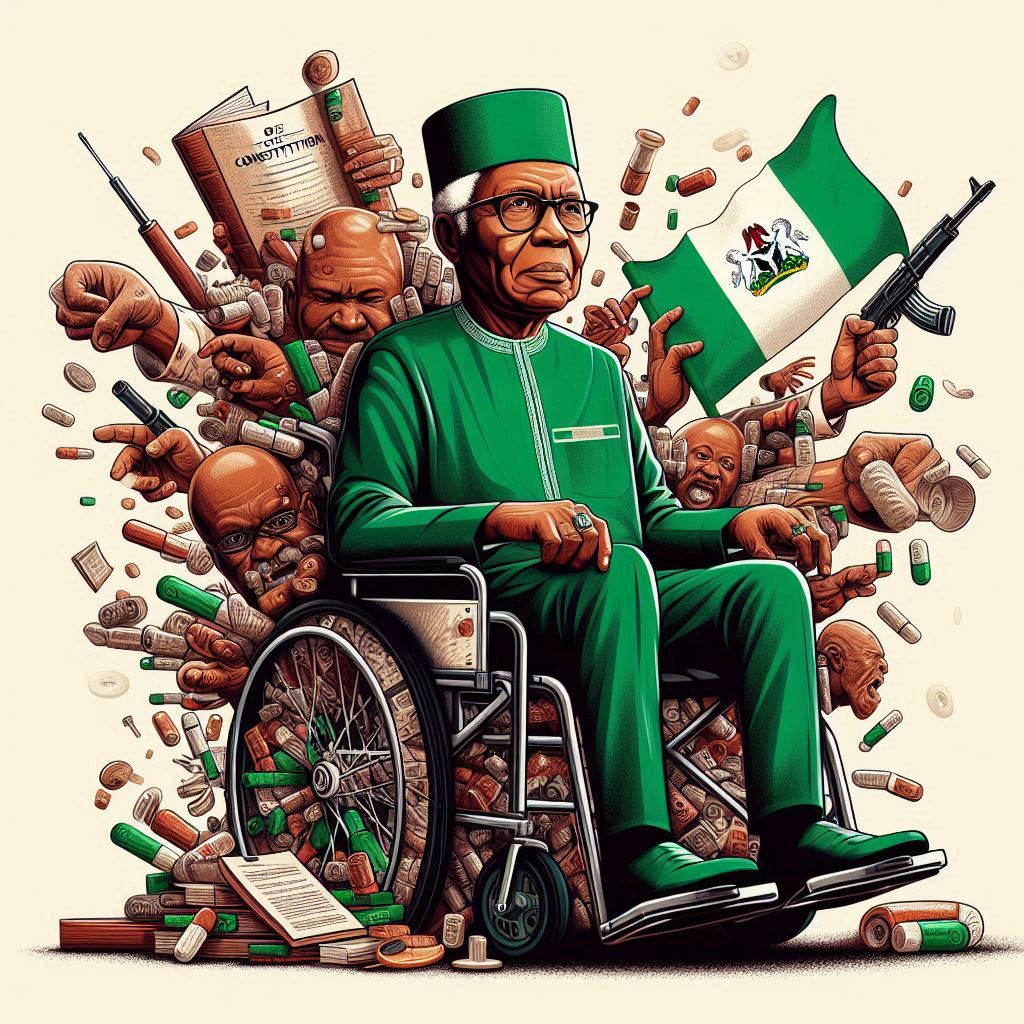OWERRI, 1969 - PART 6
LIFE IN THE 16th BRIGADE UNDER SIEGE
According to Colonel E. A. Etuk (rtd),
“The rebels knew that we were helpless because the main route that we used from Port Harcourt to Owerri was blocked totally and there was no way to go in or come out. Whenever morning came as we would sit praying, the next thing we would hear was the noise of airplanes bringing cargo to Ojukwu and soon as that was done, throughout that night the whole area would be on fire; bombing everywhere.“
Given this degree of sequestration, therefore, the only option available to 3MCDO HQ and AHQ was to resupply the beleaguered Brigade by air. In aerial logistics jargon, this is known as a “tactical airlift in support of an isolated land battle area.” Without water, ammunition, food rations, fuel, blankets, medical supplies, tents, spare parts and other equipment etc, no fighting unit can sustain morale, nor remain cohesive and effective for long.
The Owerri Airdrop
There is some disagreement about the duration of the Owerri air resupply effort. A one-time Nigerian Chief of Air Staff, the late Air Marshall Ibrahim Alfa claimed the effort actually lasted for four months while Army sources claim it lasted for six weeks. Clearly, therefore, for at least six long weeks, inclusive of the period from March 14th and continuing until April 19th 1969, air resupply was the method by which the 16th Brigade of 3MCDO was logistically supported while under Biafran siege. Even then, there were complications.
Explaining how it all began, Colonel Etuk said:
“I got in touch with Adekunle and informed him that things were really bad. He told me to find a location for drops and to let him know. I never knew that as we were discussing, the rebels were picking the message. So when that time came I told him I was going into the war zone and that there was going to be a big flame at so and so time and at so and so point. Of course, the rebels had got [the entire] message. Before that time the rebels had gone down and prepared a big flame. Adekunle rang me and said his pilot had taken off [from Port Harcourt] with all the goodies for my troops.
The poor pilot sighted that first lighting point and dropped everything there while I sat waiting because I heard the plane when it took off hovering around. The pilot must have been a stupid man for I don’t know whether he couldn’t read his map to know exactly where I told my Divisional Commander things should be dropped. The whole stock was released to the rebels.
When I got back to the radio and then called Adekunle and said I have not seen anything, he said, “You bastard son of a bitch, do you think you are the only commander I have?” The pilot went back and told him that he had delivered the goods and he said the pilot was there by him and he claimed to have dropped everything. Of course, I replied that I saw nothing. That was the beginning of my woes, no supplies.”
What the barely four-year-old Nigerian Air Force (NAF) was attempting to do at Owerri in 1969 was the resupply, by airdrop under potential hostile fire, of an army infantry brigade of about 2,000 - 3,000 men – whose numbers dropped as casualties mounted. It is not as simple as it might appear on the surface.
The field of modern aerial logistics has its major doctrinal roots in western allied experiences gained during the aerial resupply of isolated Chinese and American troops fighting in Burma and China during World War 2 on the one hand and the ‘Berlin Airlift’ of 1948 on the other. In the case of the former, military cargo planes had to fly from the Assam Valley in India, hop over the so called “Hump” of the Himalayan Mountains and then deliver supplies to Burma and China.
However, lessons learnt from tactical airlift operations during the Soviet siege of the German Sixth Army at Stalingrad (1942-43), the siege by General Giap’s Viet Minh of French troops at Dien Bien Phu (1954), and the communist siege of US Marines at Khe Sanh (1968), better illustrate the main difficulties.
At Stalingrad, 250,000 German soldiers were surrounded. At Dien Bien Phu, a 16,500 man French garrison was encircled. At Khe Sanh, about 7000 marines were bottled up. In each of these cases, the airlift effort lasted for 60, 55, and 77 days respectively. An important distinguishing feature, however, was that in each case there was initially an available re-supply airfield into which aircraft could fly – under hostile fire – and offload supplies. At Khe Sanh, (which required 235 tons per day) this was accomplished to a large degree that helped assure the survival of the besieged units until they were relieved. Viet Minh artillery, however, put the airfield at Dien Bien Phu, out of action very quickly, forcing the French to rely on aerial para-drops – which makes the Dien Bien Phu experience similar in some respects to what happened at Owerri. At Stalingrad (which required 500 - 750 tons of supplies per day) and Dien Bien Phu (which required 200 tons of supplies per day) the effort failed. Khe Sanh was a partial success, in part because of the withdrawal of the North Vietnamese Army, once the likely diversionary purpose of the siege of Khe Sanh - to distract attention from the Viet Cong Tet Offensive - had been accomplished. Importantly, however, the besieged Marines received more tonnage of supplies than they actually required before eventually being relieved by the 1st US Cavalry Division during Operation Pegasus.
Be that as it may, to start with, no aerial resupply effort can proceed without appropriate quantities and quality of aircraft. Such aircraft include not just transport aircraft equipped to do the job, flown by trained pilots in reasonably good weather and free from competing obligations, but fighter escorts to protect against intercepting opposing aircraft and bombers to suppress opposing anti-aircraft ground fire. Such transport aircraft would need airfields to fly into, or possess the equipment and skills for low-altitude parachute extraction, ground proximity extraction, or para-drops of usually aluminium-based cargo pallets. To ensure a high delivery/requirement ratio that in turn assures the appropriate tonnage per soldier ratio, such para-dropped cargo pallets should land within designated drop zones, preferably as close as possible to the desired combat impact zone.
When, however, the civil war began in 1967, the NAF had only three aircraft types, namely, a few piston engine Piaggio P.149D trainer/liaison/utility and Dornier DO-27A general purpose light transport planes, along with some light Alouette Helicopters. When the first wartime forward operational base was established at Makurdi under then Captain John Yisa Doko, the inventory expanded to include not only a few Jet Provosts handed down from Sudan and Egypt, but also two Douglas DC-3 twin-engine 21-passenger aircraft acquired from the Nigerian Airways.
The DC-3 (and its various versions) was also known as the Dakota, and is arguably one of the most successful and resilient aircraft ever built. It was not seeing combat for the first time, nor was it new to military airlift (when appropriately modified as the C-47). By 1967 it had already seen action during the Second World War, Berlin airlift, Korean and Vietnam Wars. The military version could accommodate 28 fully armed soldiers, 7500 pounds of cargo or 18 stretchers for casualties. Fully loaded, however, the civilian version could carry no more than 6000 pounds of cargo.
Just as Biafran engineers had done with an old DC-3 in their possession, NAF engineers refitted the NAF DC-3s to carry bombs and machine guns. In addition, they were used for casualty evacuation. When additional forward operational bases were opened at Calabar, Benin and Lagos, the DC-3s were moved to Enugu, while subsequently acquired long range and larger DC-4s were later based in Lagos. The DC-3s saw action over the strategic Biafran Uli-Ihiala airstrip. They were used for nighttime high-altitude combat air patrol, waiting patiently in holding pattern high in the clouds for relief aircraft to arrive below. When the runway lights were briefly turned on for incoming relief and gunrunning planes, the DC-3 would swoop down to destroy the runway. Eleven relief aircraft were destroyed and 21 relief aircraft pilots killed at Uli-Ihiala in this manner. In time to come, however, one of the “Ihiala” DC-3s was redeployed to Port-Harcourt to perform tactical airlift support for the besieged 16th Brigade at Owerri. Meanwhile, fighter jets and bombers bombed the besieging Biafran forces.
Experience gained at Stalingrad, Dien Bien Phu and Khe Sanh suggests that required resupply tonnage per soldier ranged from about 5 pounds per day per soldier at Stalingrad to 60 pounds per day per soldier at Khe Sanh. During the siege of Dien Bien Phu the calculated requirement was 25 pounds per day per French soldier. The intensity of combat, weather, terrain and the degree of mechanization of the besieged troops account for the differences. Using this range, and assuming the resupply of 2000 soldiers, it would have required at least 10000 pounds and as much as 120,000 pounds per day of accurate airdrops sustained over several months to keep the 16th Brigade in full combat mode. With one DC-3 unable to lift more than 6000 pounds of cargo, this would have meant 2 – 20 round-trip flights every day in and out of potentially hostile Owerri airspace per DC-3. And Nigeria had only two DC-3s in its inventory. This illustrative calculation shows how potentially awesome the task was, even if drops were accurate. The projection outlined does not even factor in the psychological effect on besieged front-line troops knowing that they had no option for the evacuation of serious casualties.
I commented earlier that the experience of Dien Bien Phu was relevant to Owerri. One reason is that of the three classical examples mentioned, it was only at Dien Bien Phu that supplies and reinforcements had to be exclusively delivered by parachute once the resupply airstrip was destroyed by General Giap’s guerillas. The second reason for the importance of the Dien Bien Phu experience is that the aircraft type that was most often used for aerial resupply was the C-47, which is the military variant of the DC-3. Because of the inverse relationship between the altitude at which a cargo load is dropped and its degree of dispersion, particularly when crosswinds are strong, French practice was to release cargo at low altitude, from 2500 feet. However, as opposing anti-aircraft artillery fire became more violent and effective, the drop height was adjusted upwards, first to 6000 feet, and then to 8,500 feet. The effect of these high-altitude drops, as can be surmised, was that over half of the supplies meant for the French garrison drifted outside the drop zone into grateful Viet Minh hands. They then proceeded, not only to eat the food rations and enjoy the blankets, but to load high caliber artillery rounds supplied by the French Air Force into their field guns and use them with devastating effect against the French garrison.
As Colonel Etuk (rtd) said, and Generals Oluleye and Madiebo (among others) have documented, Biafran units took custody of well over 50% of the para-dropped supplies meant for the 16th Brigade during the siege of Owerri. Air Marshall Alfa supports Etuk’s opinion that this was the result of inexperience on the part of federal pilots. But Alfa also goes further to blame high-altitude drops and lack of operational coordination between the Army and Air Force. According to him,
“The Air Force was faced with a lot of difficulties in convincing some Army Field Commanders of the need for joint planning and briefing, in that some Army Field Commanders who had little or no knowledge of air operations were impervious to useful operational suggestions from the relatively young NAF Commanders. This action often resulted in crises of confidence which disrupted the smooth operation of the war.”
However, in addition, based on what we now know, the guile of Biafran officers, logistic requirements of the besieging Biafran units, and limited ability of the besieged Brigade to support airdrop operations in an increasingly small drop zone must be factored in. Until towards the very end, although unaware at that time, NAF pilots tasked with the resupply of the 16th Brigade had no need to fly at high altitude because Biafran anti-aircraft units – fully aware of their flight times and drop arrangements - had no intention of shooting them down. Neither, even if they wanted, at that stage of the war, was there any effective Biafran air combat or interceptor capability. The devastating ground attack of Count Von Rosen’s MFI-9B ‘miniCOIN’ aircraft against Port-Harcourt airport during “Operation Biafra Babies” took place on May 22nd – well after the Owerri situation had resolved itself. Thus, maintenance of air-superiority – which is always a big concern for military transports – was not in the picture. Airlift distance was not a problem for federal pilots either. The airlift distance from Port-Harcourt to Owerri was only about 40 miles. The flight from Enugu was just over 60 miles. There is no record of Biafran commandos attempting to sabotage federal airfields from which DC-3s were taking off for Owerri, as occurred during the siege of Dien Bien Phu. Viet Minh commandos immobilized over 70 French transport planes on the ground at the Cat Bi and Gia airfields to undermine tactical air resupply of the beleaguered French garrison.
Instead, the Biafrans made arrangements to collect from the DC-3 overflights at Owerri what they had been denied by DC-3 airfield denial attacks at Uli-Ihiala. According to Madiebo,
“After two months of daily promises of a link-up by Port Harcourt had failed, the enemy resorted to air dropping of ammunition and food. What was left under enemy control in Owerri was so small that most of what was dropped fell into Biafran hands. Any Biafran unit around Owerri which wanted something dropped for it by the enemy, only needed to clear a bit of bush, spread a white sheet of cloth over the clearing, and he would get a drop. Unfortunately, due to the gross inefficiency of the enemy air-drop operations, the very large quantity of ammunition we acquired through it was almost all damaged and therefore useless to the Army. Gunpowder was however laboriously extracted from the damaged ammunition for use by the BOFF and other civil defence organisations. As a result of enemy air drops, the 14 Division was for some time fairly well fed and thus became fitter for its operations.“
This situation was obviously frustratingly evident to the men of the 16th Brigade. According to Colonel Etuk (rtd),
“They [NAF] used passenger aircraft to be dropping things – so you come and see another line of battle – when this plane started coming and hovering around town, the rebels were waiting – when they knew that the plane was there they would be waiting for any drop that came – so it was a battle for my troops to be able to collect these things and for the rebels to – so it was cross-fire. So this thing continued and continued; each time the plane took off [from Port Harcourt] everybody was ready. At times the pilot would come but because of the firing from the rebels he would go back with all the cargo. He couldn’t come down nor could he even go within the level at which he should drop these things.”
The interesting thing about this scenario is that at no time were the NAF resupply DC-3s accompanied by NAF bombers. Tactical airdrops – usually launched in response to requests from the Divisional Commander - occurred independently of close air-support and ground-attack missions, which took place at other times!
“Biafra Kwenu!”
Quite apart from the drama of airdrops, life in the 16th Brigade under siege provided an opportunity to become intimately familiar with the mettle of opposing Biafran troops. According to Colonel Etuk (rtd),
“They [Biafrans] were more determined than the Federal troops from my own assessment because as a field commander certain times you move and think it was just going to be a child’s play but by the time you get there you’ll be faced with a different situation [sic] entirely. You may, for example, reach a point where you’ll have to dislodge three rebels. [Then] at a point you realize [sic] that you have put up a strong battle to dislodge them.
What about the woman who had always been threatening my troops, a female Captain! So a number of times my boys will come and say as soon as this woman comes she will stand just on the road like that and with her walking stick as soon as she surfaces she will say, “Biafra Kwenu! Biafra Kwenu!” They will follow up.
So one day, one Fulani boy came to me and said, “Oga, Walahi! Talahi! Zai kacheta” meaning, “I will kill her.” I asked him how he was going to do that. So when she came and started doing all that the boy just kept quiet. He took [sic] only one round. He dropped it on the ground and sharpened it, squeezed the sand off, tucked it in, aimed at her – because each time she came she would do that [and] the boys would run away. The boy aimed and got her right there and by the time we went to and recover the body – Oh! My God! That is why I said the rebels were determined. For us to succeed in getting this woman it was a tug of war. The rebels refused to let us carry this woman.”
THE 16th BRIGADE’S BREAKOUT FROM ENCIRCLEMENT
CONTINUED
RETURN

Review of “Evolution of Leadership Research by Larry D. Mathis, PhD, DMin “ The book was first brought to my attention by Shawn Mathis, Ph. D...

This article was first published on November 12, 2024, on https://constitutionaldiscourse.com/a-game-for-the-throne-the-nigerian-constitution-and-the-...

Civil Society and Social Movements: The Role of Activism and Radical Politics in Deepening Democracy in AfricaByOtive Igbuzor, PhDFounding Executive D...

Chimaroke Nnamani: Progenitor of Ebeano politics at 64By Paul MumehChimaroke-Nnamani2.jpg 88.87 KBHate or love him, Senator Chimaroke Nnamani; fo...

Background To The Recent Nigerian ElectionsGeneral Obasanjo more than just a "friend" of the AmericansElizabeth Liagin is an independent journalist wh...